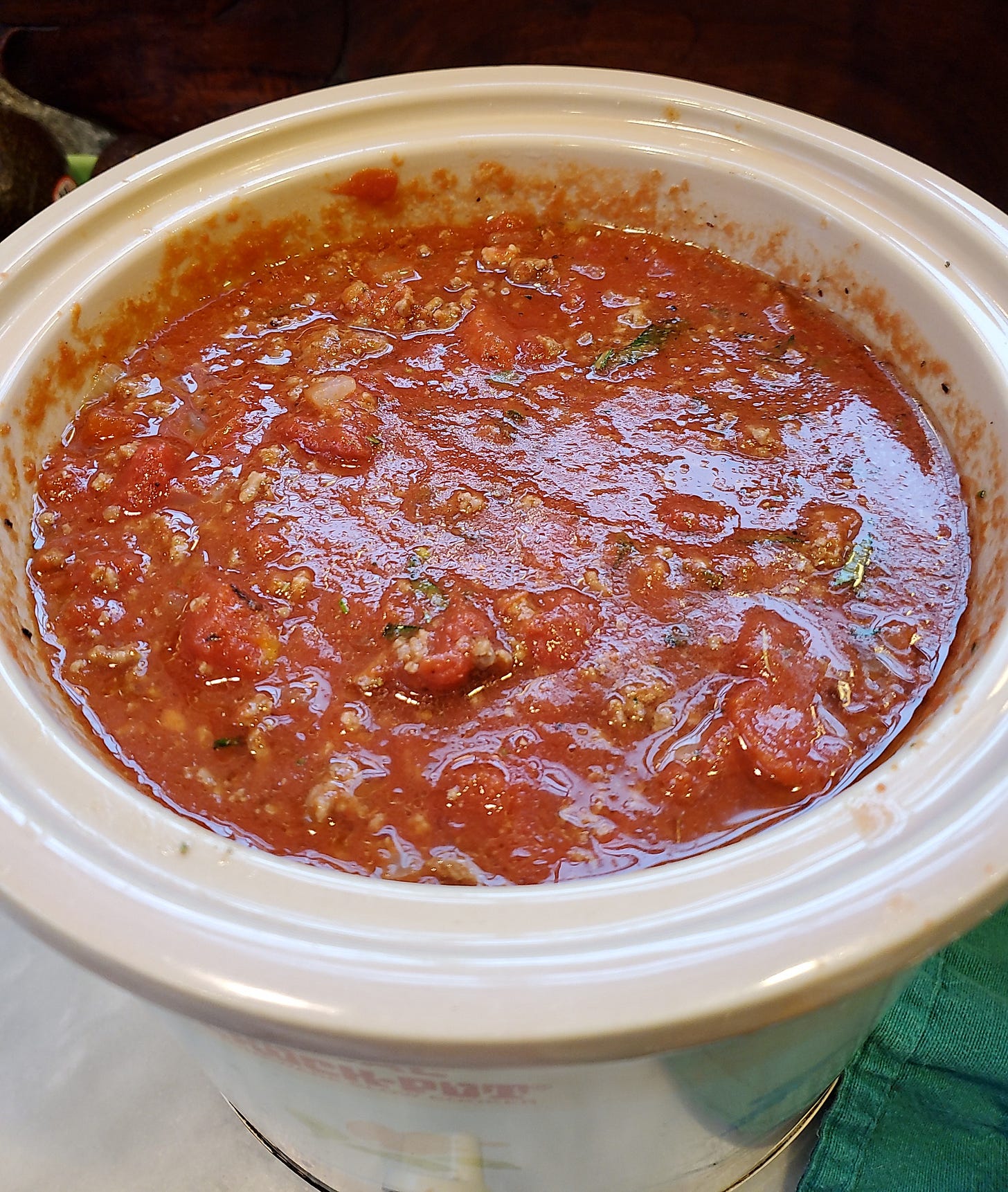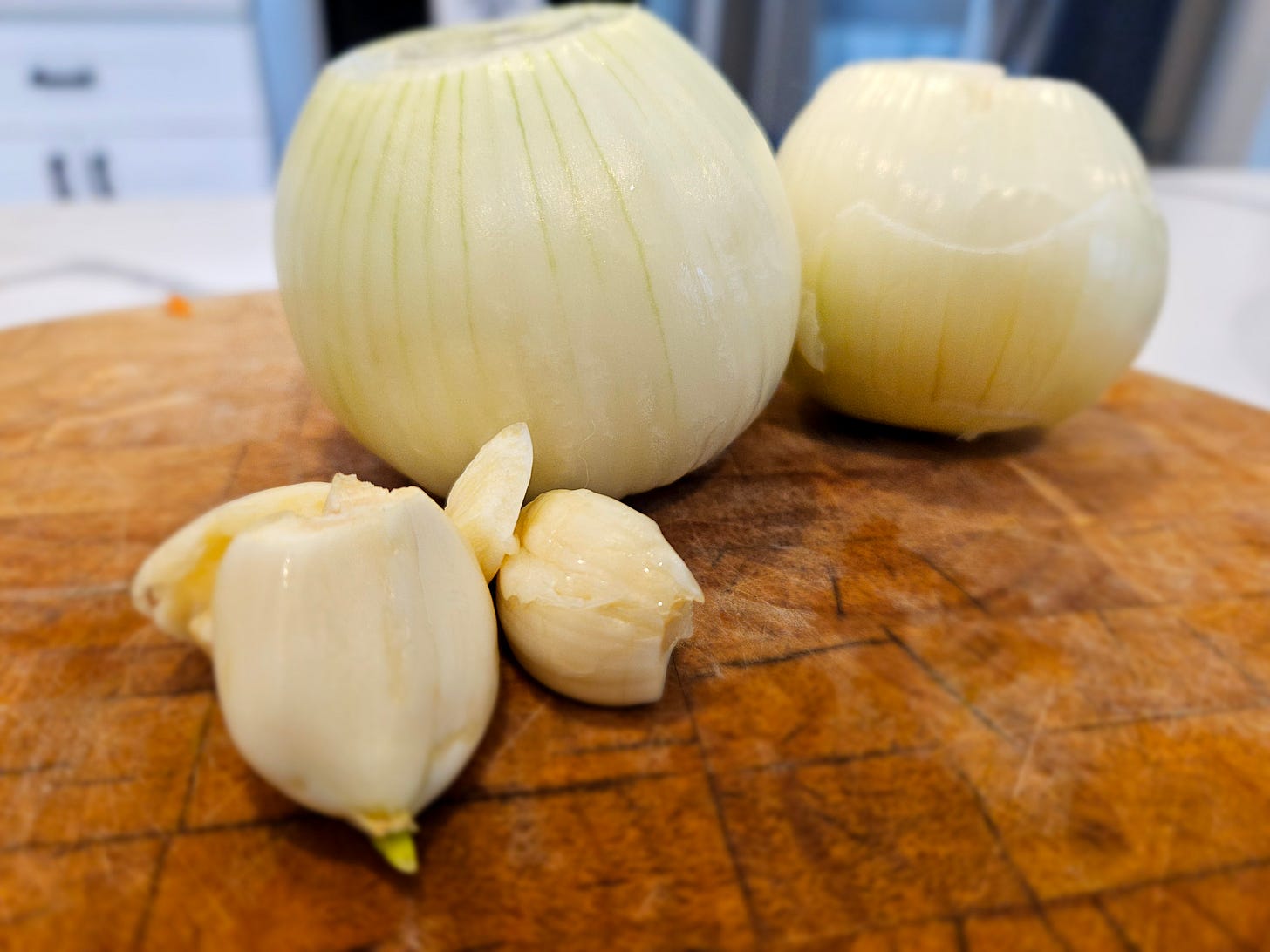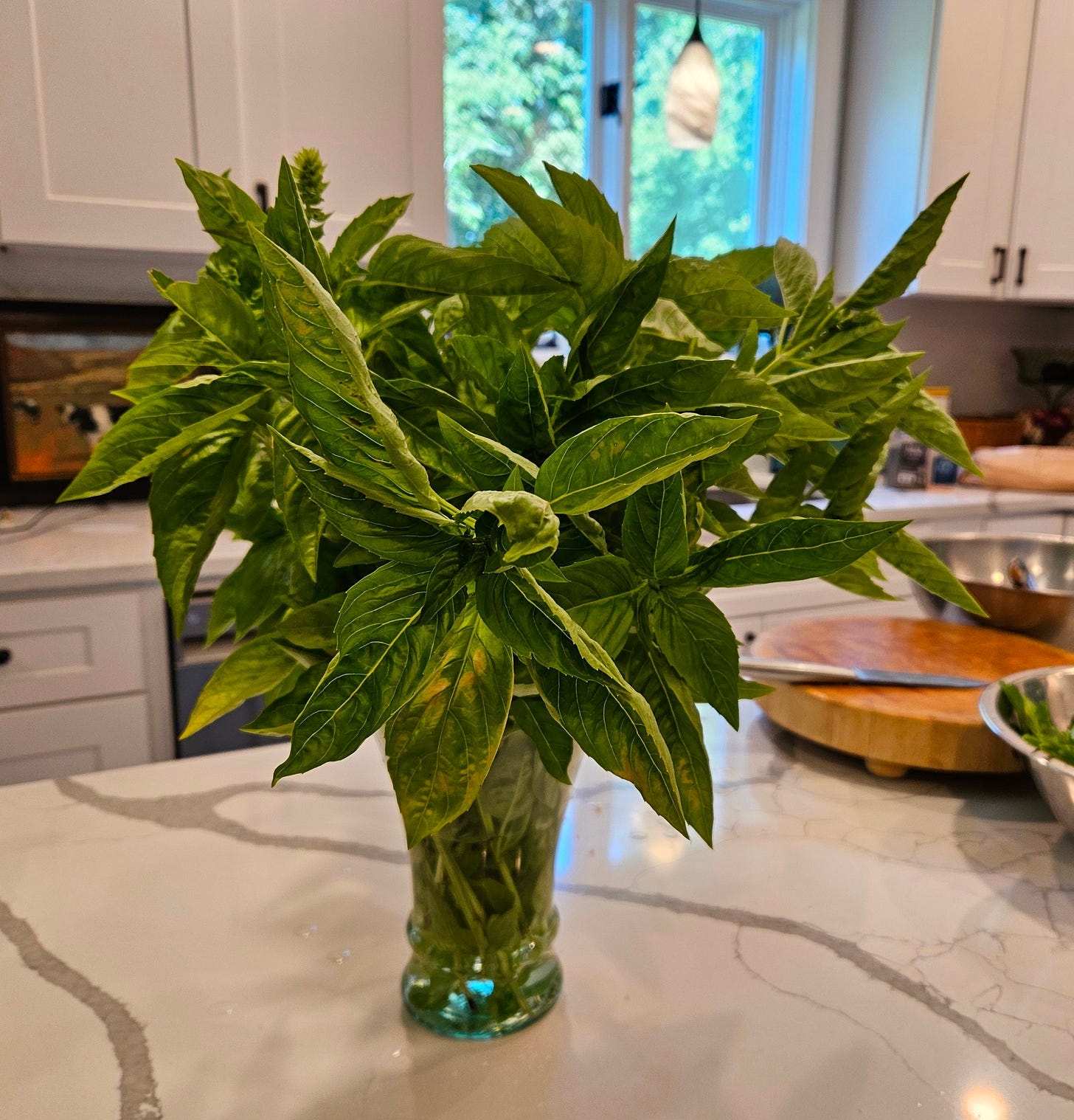How to Eat Spaghetti
This excerpt from a longer foodie memoir includes a recipe with cooking tips for your dog for paid subscribers.
For the first few years of my life, food was just sustenance. Don’t get me wrong. I liked food. I ate it, and that’s why I’m largely here today. (Perhaps put the emphasis on largely.) Our family’s approach to dining was simple: breakfast when I woke up, lunch sometime in the afternoon, and dinner when Dad came home from work in the evening. After we said grace, I ate whatever my parents were having, but chopped and flown into my mouth on a spoon airplane, the one that parents use to keep their children’s hands out of the food and to get them to eat stuff they detest.
When I was into my third year, my new little sister became my saving grace, and supper became a special meal—not because we ate together as a family nor because of the aromas in the kitchen or the lovely tinkling sounds of silverware or our sing-song chatter in Italian peppered with English. I was satisfied because, preoccupied with la bambina, my parents left me to pursue my own gastronomic interpretations, and secretively drop my lima beans to Rocky. Good dog.
I was just developing my taste buds so I couldn’t claim any real discriminating palate, although, like most children, I had a yen for spaghetti. They say, “a third of the world eats with chopsticks, a third with their hands, and a third with a fork or spoon”—that is, except for Italians eating spaghetti. In the decade known for mini-skirts, bell bottoms, beaded headbands, and countercultural movements, I leaned into the high fashion of Italian culinary practice at the time—eating spaghetti with a fork and a spoon. (Note: “leaned into” is not just a metaphorical expression.)
The Ingredients
One bowl of spaghetti cooked al dente (because we are Italian) with deep red tomato sauce ladled over, and one small meatball per serving (because we are poor). One spoon. One fork. One small child on a pile of World Book Encyclopedias (because I need a booster seat).
Serving tip: Keep napkins close by as spills are likely, but a bib is always better.
Servings: Half for the child, and half for the dog under her seat.
The Directions
While parents are lightly folding spoonfuls of a chopped mixture into the child sitting in the highchair, let the older one marinate in her own juices.
Spoon grated cheese on top of spaghetti careful not to let any of the red sauce poke through the coating of snow, (as my father called it). After this procedure, wait a few seconds to endure scalding looks from the parents, (because, as a New England girl, you like your spaghetti covered in a blizzard).
Carefully—lovingly—wind a wickedly small tad (because we live in Massachusetts) of spaghetti, around the fork in the right hand while steadying it on a spoon held in the left hand. The idea is to use the spoon to guide the fork while twirling the pasta, but I was just learning to tie my shoes, so this method was still under construction. At some point, I made up my own directions: Let go of the spoon and use both hands to turn the fork making about two 360 degree turns, and flip spaghetti strands about the plate and table. Tip for children: Repeat at least half a dozen times. If all goes smoothly, you will have a tightly wound bundle of spaghetti around the fork. Then, guide right hand holding fork with spoon in left hand and bring coiled spaghetti strands to mouth. I modified the directions and involuntarily brought my face close—very close—to the plate (because here’s the non-metaphorical “leaning into” part) knowing from experience that the little cocoon of spaghetti tendrils would disentangle themselves from the tines of the fork faster than it had taken me to twirl them up. A single strand would make it into my mouth, the rest unraveling down the bib covering my blouse, and some directly into Rocky’s panting mouth. When I looked up, the spaghetti, like fat little brushes, had painted red whiskers on my cheeks.
They say, “practice makes perfect,” so, delighted and undeterred, I played at this game until my plate was clean. This was my favorite recipe.
EASY PASTA SAUCE
This recipe is very forgiving and simple. The ingredients do not have to be exact. Use more or less of any ingredient depending on what you have, your taste, and how much sauce you want to make. The trick to making it taste good is to let it cook long enough, and not to use too many ingredients. I don’t use sugar, wine, soy sauce, a chunk of cheese or anything else I often see in other recipes.
I like to make a meat sauce, because it’s simpler than making meatballs, but you can substitute the hamburger for actual meatballs if you prefer. Put them in the sauce to cook and let the flavors meld. You can use only hamburger or only sausage if you prefer. I like the combination of meats, and I use Italian sausage because it’s already seasoned.
Make this sauce in a slow cooker on high for a few hours or all day/night on low. You can also simmer it on a stove (including wood-burning, as my mother used to do when we moved to the country), but you will need to keep an eye on the temperature.
Ingredients
1 pound of ground hamburger or beefalo (as I had as a child)
1 package of Italian-style sausage, broken up or cut into pieces (can be sweet, spicy, or a combination, but the sauce tastes great if the sausage is already seasoned)
1 medium onion, chopped (optional if this is a dietary concern.)
1-2 cloves garlic chopped (optional if this is a dietary concern)
1-2 tablespoons olive oil (extra virgin is using to finish the sauce)
2 16 oz cans of Marzano whole tomatoes, using more or less depending on the amount you wish to make (added basil is fine)
2 tablespoons tomato paste
Water, for adjusting the thickness of the sauce
2 cubes chicken bullion
Use a couple of shakes of prepared Italian seasoning. Or use herbs to taste, about 1 tablespoon of each: Basil (fresh or dried), leaves torn. I dry the basil from my garden and use this in the off season. Oregano, dried. Parsley (fresh or dried) chopped fine if fresh.
Salt and pepper to taste
Directions
Open the cans of tomatoes and pour them into the pot you will use for cooking. With your hands (or a fork and knife, but these are not as fast or efficient as your hands), carefully squeeze the tomatoes (so you don’t splatter the juice on you) to break them up. Rinse the tomato cans with a little water and pour into the pot.
Add the tomato paste to the tomatoes in the pot.
You can begin to simmer the tomatoes on the stove or turn on the slow cooker at this point.
In a frying pan with a little olive oil, brown the hamburger over medium heat, adding the herbs, salt and pepper, bullion cubes, and the chopped garlic (if using) as the meat begins to brown. Mix together and cook a few more minutes being careful not to brown the garlic. Remove the meat with a spoon and add to the tomatoes, keeping most of the fat in the pan. The meat doesn’t need to be fully cooked as it will cook in the sauce. The important thing is to season the meat with the seasonings before adding it to the tomatoes.
Add the sausage to the pan and brown on all sides if using pieces or break up with a wooden spoon while cooking the meat. Remove the meat, keeping most of the fat in the pan, and add the sausage to the tomato mixture.
Remove most of the fat from the pan and return the pan to the stove. Fry the onion (if using) in the fat until translucent, a few minutes. Add the onion to the tomato mixture, keeping back most of the fat in the pan. (You can use the discarded fat, if you haven’t cooked garlic or onions with it, to cook dog food.)
Stir the meat sauce. Add a little water if the sauce is too thick. The tomatoes will break down, so don’t worry if they seem a little big.
It’s time to cook the sauce. There are several options. Let the sauce simmer on the stove for about two hours. Stir occasionally if cooking on a stove, and adjust the temperature. I have cooked the sauce in the oven at 300° for about three hours. If you’re using a slow cooker, remember the adage, “If you’re looking, it ain’t cooking.” Wait at least two hours before stirring the sauce in the slow cooker. I cook the sauce for about four hours on high in a slow cooker or for about six to eight hours on low depending on my cooker’s fickleness. Adjust for seasonings no matter your cooking method. I usually need more salt and pepper, and another bullion cube.
Before serving the sauce, add a ladle-full of pasta water into the sauce and stir to give the sauce a silky texture. You can also finish with a drizzle of extra virgin olive oil to taste.
Use this sauce with regular spaghetti or a thicker or fatter pasta, or in lasagna. It goes well over paradelle, penne, and rigatoni. I like to mix the freshly cooked pasta and some of the sauce in a bowl before serving and pass extra sauce on the side at the table. Use freshly grated Italian cheese (any single cheese like Parmesan, or a combination of cheeses). You can also stir in ricotta or add a dollop on top or pass a bowl of the cheese at the table.
If you have leftovers, you can combine the pasta and sauce to store or keep them separately depending on how you will use them. The pasta will absorb liquid from the sauce and become soft if you combine them. If you don’t add some sauce to the pasta, it can become dry. Since the meat sauce is easily heated for another meal, I try to only cook enough pasta for the meal, and cook fresh pasta for the leftover sauce.
For dogs. I add a couple of chopped spoonfuls of pasta to my dogs’ food as long as there is no garlic or onion. My dogs cannot tolerate a lot of tomato, but the pasta can replace rice or barley in their food. If I know I will be cooking a lot of meat, I will separate at the beginning of the cooking process and store some it for the dogs since dogs cannot eat garlic or onions.








